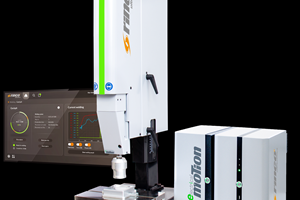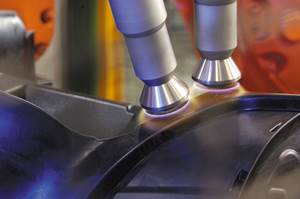Lasers Now Clean Molds and Parts
They drill, cut, weld, polish, engrave, and print.
They drill, cut, weld, polish, engrave, and print. Now here’s something else you can do with lasers—clean molds and parts. Adapt Laser Systems (ALS) applies lasers to non-contact, non-destructive cleaning of injection, compression, and blow molding tools. In addition, lasers can strip contaminants from surfaces of parts to prepare them for decorating or bonding.
ALS is exclusive distributor in North America of laser cleaning systems made by Clean Laser Systems in Aachen, Germany. The equipment comes in 120-W and 500-W versions, each configurable as a portable system or a stationary system for automated production lines. The format most frequently used by processors is a 120-W, stationary system priced at about $125,000, reports Georg Heidelmann, president of ALS.
"Laser cleaning is a precise, cost-effective method for cleaning metal tools when traditional methods fall short," Heidelmann declares, referring to mechanical abrasion, chemical purging, and CO2 ablation. Cleaning lasers are adept at removing additives, colorants, grease, rust, and other contaminants from tool surfaces, while also minimizing abrasion and heat build-up.
ALS’s equipment directs a programmable scanning beam of up to 0.02 in. diam. from a Nd:YAG pulsed, solid-state laser. The metal tool surface reflects laser energy and is minimally affected by it. However, the contaminants on the tool surface absorb the laser energy and are quickly vaporized. Cleaning speed is proportional to the contaminant’s ability to absorb laser energy. Any fumes or particulates are removed by a filter built into the equipment.
Cleaning stops once the contaminant is consumed, and heat build-up is modest. This method reportedly avoids the microscopic roughening and cracking of metal surfaces that sometimes occurs with traditional cleaning methods, thus extending tool life.
Heidelmann says molds can be cleaned in place, without disassembly or removal, when either cool or hot. That means minimal disruption of production schedules and less downtime. Low energy use and lack of consumables keep costs low. Laser cleaning is said to be ideal for applications where molds need frequent cleaning or when mold geometry restricts access to hidden areas. However, lasers need "line-of-sight" access to areas being cleaned, and the color and chemistry of contaminants can affect their ability to absorb energy.
Practical uses surface
Around 50 Clean Laser Systems machines are currently in commercial use, mostly in Europe. Several are used by plastics processors to clean tools or prepare part surfaces. One system is employed in cleaning high-cavitation tools for small electronic parts in which the intricate cavities are hard to reach.
Other applications involve laser treatment of part surfaces to facilitate adhesion. An example is seating for the new BMW 3 series vehicles. Laser cleaning removes residual mold release from the polyurethane parts, ensuring good bonding when the parts are joined to others in seating assemblies.
In another instance, a laser cleaning system is used to roughen the surface of bonding points on a PC part where adhesion strength is critical.
Laser cleaning is also used to replace costly masking steps—e.g., in a nickel-coated housing for a consumer electronic device. In this case, the part is uniformly nickel plated and then the laser removes the nickel from specific areas, making those areas more receptive to decorative chrome plating.
Laser cleaning is also used in continuous, high-speed removal of a protective film from metal edging profiles that require protection. Laser energy passes through the clear protective film and melts the adhesive underneath. The result is high-speed separation of film from the profile.
Related Content
Next-Generation Fully Electric Ultrasonic Welding System
NPE 2024: Rinco new eMotion servo-driven machine is available in 20 kHZ and 35 kHz frequencies.
Read MoreHigh-Throughput, Robust Thermoformer
NPE2024: WM Thermoforming’s new generation of FC1000 IM2 offers the highest throughput per square feet.
Read MorePlasmatreat's Technology is Transforming Manufacturing with Innovation and Sustainability
NPE2024: Advancements and forward-thinking initiatives in plastics manufacturing will be highlighted.
Read MorePolyfuze Graphics Corp. Partners With RFID Specialists
To help customers navigate the complexities of RFID technology, Polyfuze has partnered with such companies as HID Global.
Read MoreRead Next
For PLASTICS' CEO Seaholm, NPE to Shine Light on Sustainability Successes
With advocacy, communication and sustainability as three main pillars, Seaholm leads a trade association to NPE that ‘is more active today than we have ever been.’
Read MoreSee Recyclers Close the Loop on Trade Show Production Scrap at NPE2024
A collaboration between show organizer PLASTICS, recycler CPR and size reduction experts WEIMA and Conair recovered and recycled all production scrap at NPE2024.
Read MoreBeyond Prototypes: 8 Ways the Plastics Industry Is Using 3D Printing
Plastics processors are finding applications for 3D printing around the plant and across the supply chain. Here are 8 examples to look for at NPE2024.
Read More











